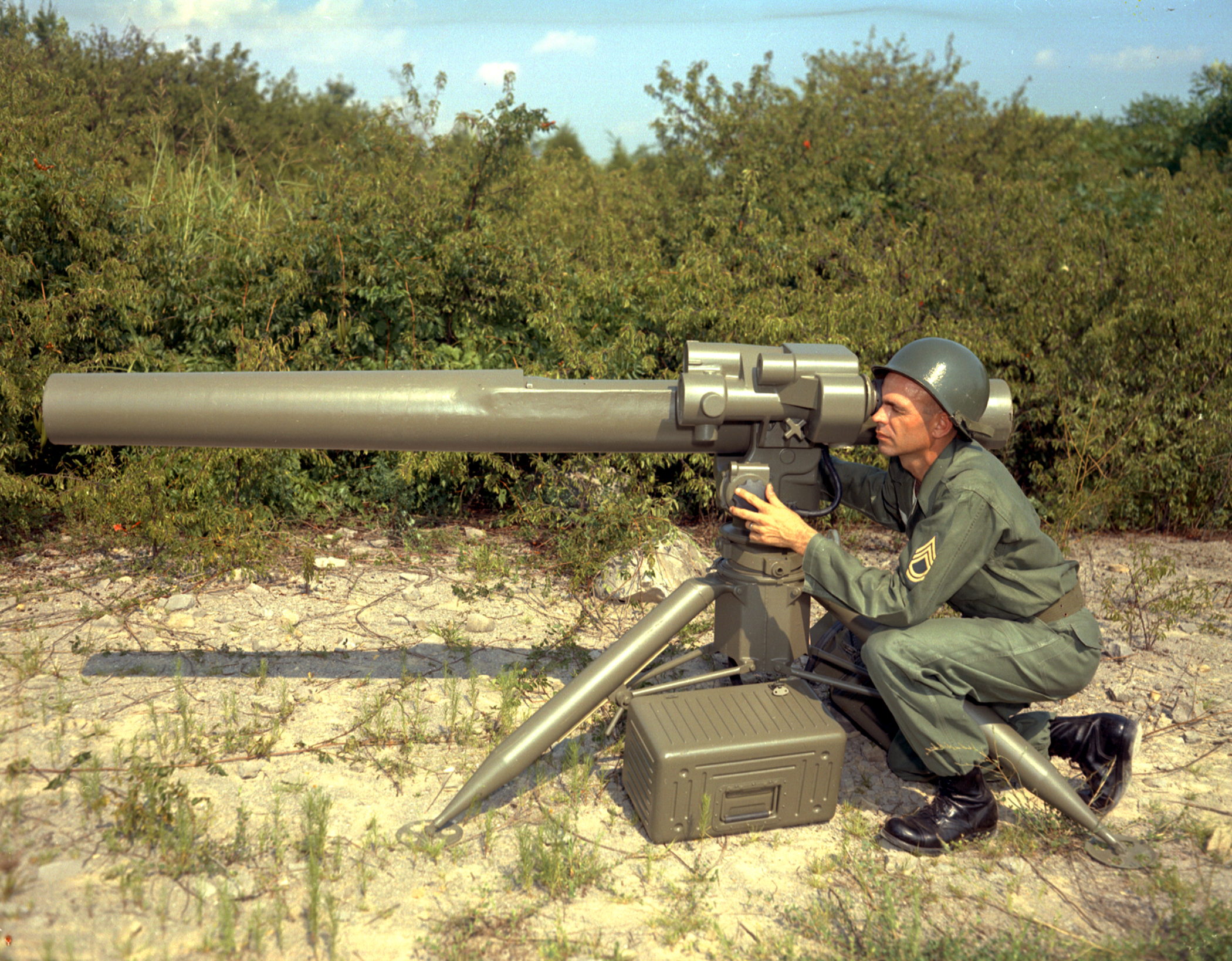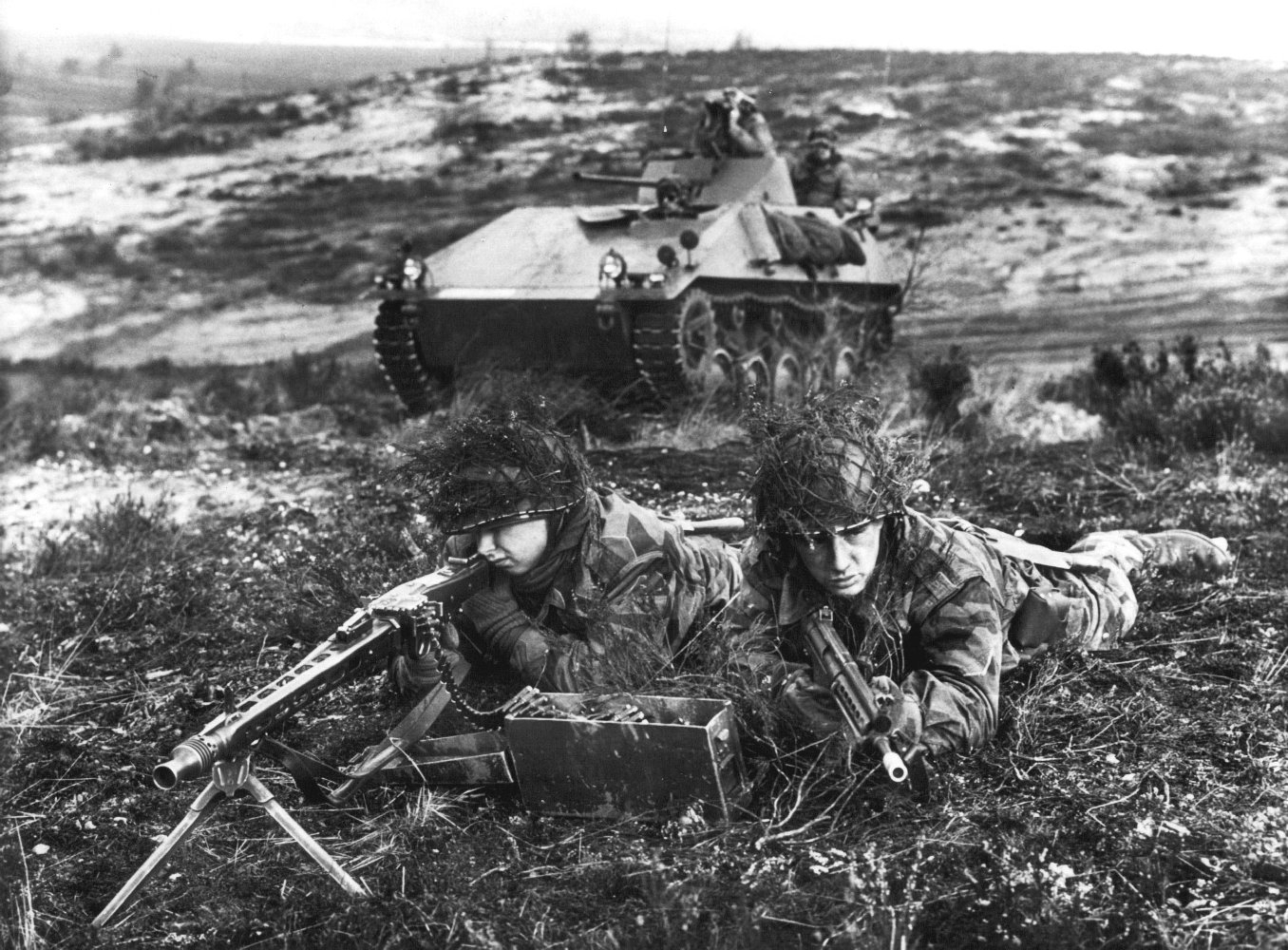|
Pegaso BMR
The Pegaso 3560 BMR (Spanish acronym of "Blindado Medio sobre Ruedas", "Medium Armored on Wheels") is a 6x6 wheeled armoured personnel carrier produced in Spain by Enasa since 1979. Technical characteristics Originally powered by a Pegaso 9157/8 306 hp diesel engine, it has an automatic gearbox, torque converter, independent suspension in all six wheels and amphibious capability. It can also be transported by air. It has received different kind of weapons throughout its life and there is also a field ambulance version. As part of its optional amphibious equipment, it has two hydrojets for travel through water. Pegaso BMRs are used by Spanish, Egyptian, Saudi Arabian, Moroccan and Peruvian Armies. The Spanish Army BMRs (or BMR-600) have been instrumental in the performance of Spanish forces in international interventions in Yugoslavia, Afghanistan, Iraq and Lebanon. In the last few years, all of them had their original Pegaso engines replaced by new 310 hp Scan ... [...More Info...] [...Related Items...] OR: [Wikipedia] [Google] [Baidu] |
Spanish Army BMR-600 DF-SD-04-06607
Spanish might refer to: * Items from or related to Spain: **Spaniards are a nation and ethnic group indigenous to Spain **Spanish language, spoken in Spain and many Latin American countries **Spanish cuisine Other places * Spanish, Ontario, Canada * Spanish River (other), the name of several rivers * Spanish Town, Jamaica Other uses * John J. Spanish (1922–2019), American politician * "Spanish" (song), a single by Craig David, 2003 See also * * * Español (other) * Spain (other) * España (other) * Espanola (other) * Hispania, the Roman and Greek name for the Iberian Peninsula * Hispanic, the people, nations, and cultures that have a historical link to Spain * Hispanic (other) * Hispanism * Spain (other) * National and regional identity in Spain * Culture of Spain * Spanish Fort (other) Spanish Fort or Old Spanish Fort may refer to: United States * Spanish Fort, Alabama, a city * Spanish Fo ... [...More Info...] [...Related Items...] OR: [Wikipedia] [Google] [Baidu] |
Scania AB
Scania AB is a major Swedish manufacturer headquartered in Södertälje, focusing on commercial vehicles—specifically heavy lorries, trucks and buses. It also manufactures diesel engines for heavy vehicles as well as marine and general industrial applications. Scania was formed in 1911 through the merger of Södertälje-based Vabis and Malmö-based Maskinfabriks-aktiebolaget Scania. Since 1912, the company has been re-located again to Södertälje after the merger. Today, Scania has production facilities in Sweden, France, the Netherlands, Thailand, China, India, Argentina, Brazil, Poland, Russia and Finland. In addition, there are assembly plants in ten countries in Africa, Asia and Europe. Scania's sales and service organisation and finance companies are worldwide. In 2012, the company employed approximately 42,100 people around the world. Scania was listed on the NASDAQ OMX Stockholm stock exchange from 1996 to 2014. The company is a subsidiary of Traton, part of the Vo ... [...More Info...] [...Related Items...] OR: [Wikipedia] [Google] [Baidu] |
HOT (missile)
The HOT (French: ''Haut subsonique Optiquement Téléguidé Tiré d'un Tube'', or High Subsonic, Optical, Remote-Guided, Tube-Launched) is a second-generation long-range anti-tank missile system. It was originally developed to replace the older SS.11 wire guided missile in French and West German service. The design was a collaboration between the German firm Bölkow and the French firm Nord. Bölkow and Nord later merged into MBB and Aérospatiale respectively, both of which then formed Euromissile to design and produce the MILAN, Roland and HOT. This ultimately became part of MBDA. In comparison to the SS.11, HOT has longer range, flies faster, and is semi-automatically guided instead of manually. It has become one of the most successful missiles of its class, with tens of thousands of missiles produced, used by no fewer than a dozen countries worldwide, and validated in combat in several wars. The missile system is also commonly mounted on light and medium armored vehicles ... [...More Info...] [...Related Items...] OR: [Wikipedia] [Google] [Baidu] |
Nuclear, Biological, Chemical
Chemical, biological, radiological and nuclear defence (CBRN defence) are protective measures taken in situations in which chemical, biological, radiological or nuclear warfare (including terrorism) hazards may be present. CBRN defence consists of CBRN passive protection, contamination avoidance, and weapons of mass destruction mitigation. A CBRN incident differs from a hazardous material incident in both scope (i.e., CBRN can be a mass casualty situation) and intent. CBRN incidents are responded to under the assumption that they are intentional and malicious; evidence preservation and perpetrator apprehension are of greater concern than with HAZMAT incidents. A 2011 forecast concluded that worldwide government spending on CBRN defence products and services would reach US$8.38bn that year. Etymology In English the term ''CBRN'' is a replacement for the 1960s–1980s term ''NBC'' (nuclear, biological, and chemical), which had replaced the term ''ABC'' (atomic, biological, ... [...More Info...] [...Related Items...] OR: [Wikipedia] [Google] [Baidu] |
BGM-71 TOW
The BGM-71 TOW ("Tube-launched, Optically tracked, Wire-guided") is an American anti-tank missile. TOW replaced much smaller missiles like the SS.10 and ENTAC, offering roughly twice the effective range, a more powerful warhead, and a greatly improved semi-automatic command to line of sight (SACLOS) that could also be equipped with infrared cameras for night time use. First produced in 1970, TOW is one of the most widely used anti-tank guided missiles. It can be found in a wide variety of manually carried and vehicle-mounted forms, as well as widespread use on helicopters. Originally designed by Hughes Aircraft in the 1960s, the weapon is currently produced by Raytheon. History Previous designs Late in World War II, the German Army began experimenting with modified versions of the Ruhrstahl X-4 wire-guided missile. Originally developed for the ''Luftwaffe'' as an anti-bomber weapon, by changing the warhead to one using a high-explosive anti-tank (HEAT) design, the new X-7 vers ... [...More Info...] [...Related Items...] OR: [Wikipedia] [Google] [Baidu] |
ATGM
An anti-tank guided missile (ATGM), anti-tank missile, anti-tank guided weapon (ATGW) or anti-armor guided weapon is a guided missile primarily designed to hit and destroy heavily armored military vehicles. ATGMs range in size from shoulder-launched weapons, which can be transported by a single soldier, to larger tripod-mounted weapons, which require a squad or team to transport and fire, to vehicle and aircraft mounted missile systems. Earlier man-portable anti-tank weapons like anti-tank rifles and magnetic anti-tank mines, generally had very short range, sometimes on the order of metres or tens of metres. Rocket-propelled high-explosive anti-tank (HEAT) systems appeared in World War II and extended range to the order of hundreds of metres, but accuracy was low and hitting targets at these ranges was largely a matter of luck. It was the combination of rocket propulsion and remote wire guidance that made the ATGM much more effective than these earlier weapons, and gave lig ... [...More Info...] [...Related Items...] OR: [Wikipedia] [Google] [Baidu] |
MILAN
Milan ( , , Lombard: ; it, Milano ) is a city in northern Italy, capital of Lombardy, and the second-most populous city proper in Italy after Rome. The city proper has a population of about 1.4 million, while its metropolitan city has 3.26 million inhabitants. Its continuously built-up urban area (whose outer suburbs extend well beyond the boundaries of the administrative metropolitan city and even stretch into the nearby country of Switzerland) is the fourth largest in the EU with 5.27 million inhabitants. According to national sources, the population within the wider Milan metropolitan area (also known as Greater Milan), is estimated between 8.2 million and 12.5 million making it by far the largest metropolitan area in Italy and one of the largest in the EU.* * * * Milan is considered a leading alpha global city, with strengths in the fields of art, chemicals, commerce, design, education, entertainment, fashion, finance, healthcar ... [...More Info...] [...Related Items...] OR: [Wikipedia] [Google] [Baidu] |
Explosive Ordnance Disposal
Bomb disposal is an explosives engineering profession using the process by which hazardous explosive devices are rendered safe. ''Bomb disposal'' is an all-encompassing term to describe the separate, but interrelated functions in the military fields of explosive ordnance disposal (EOD) and improvised explosive device disposal (IEDD), and the public safety roles of public safety bomb disposal (PSBD) and the bomb squad. History The first professional civilian bomb squad was established by Sir Vivian Dering Majendie. As a Major in the Royal Artillery, Majendie investigated an explosion on 2 October 1874 in the Regent's Canal, when the barge 'Tilbury', carrying six barrels of petroleum and five tons of gunpowder, blew up, killing the crew and destroying Macclesfield Bridge and cages at nearby London Zoo. In 1875, he framed The Explosives Act, the first modern legislation for explosives control. He also pioneered many bomb disposal techniques, including remote methods for the ha ... [...More Info...] [...Related Items...] OR: [Wikipedia] [Google] [Baidu] |
LAG-40
The SB-40 LAG is a 40 mm automatic grenade launcher developed and produced in Spain by the Empresa Nacional Santa Bárbara (EN SB) company (currently a part of the European Land Systems Group of General Dynamics). Users * : Used by Brazilian Marine Corps (Mounted on Piranha IIIC). * : The Colombian Navy uses the SB-40 LAG grenade launcher installed on a turret on the ARC Juan Ricardo Oyola Vera riverine patrol boat. * : Used by the Philippine National Police Special Action Force either on tripod or mounted on light utility vehicles, and by Philippine National Police Maritime Group mounted on patrol crafts * : used on M-11D scout cars (Panhard VBLs) * : used by the Spanish Army (Ejército de Tierra de España), Spanish Navy Marines and Guardia Civil Española. See also *Denel Y3 AGL - automatic grenade launcher used by South Africa. *Heckler & Koch GMG - A 40 mm automatic grenade launcher used by the German Army and other European armed forces. *XM174 grenade launcher, ... [...More Info...] [...Related Items...] OR: [Wikipedia] [Google] [Baidu] |
MG1A1
The MG 3 is a German general-purpose machine gun chambered for the 7.62×51mm NATO cartridge. The weapon's design is derived from the World War II era MG 42 ''Einheitsmaschinengewehr'' (Universal machine gun) that fired the 7.92×57mm Mauser round.Woźniak, Ryszard: ''Encyklopedia najnowszej broni palnej—tom 3 M-P'', page 106. Bellona, 2001. The MG 3 was standardized in the late 1950s and adopted into service with the newly formed ''Bundeswehr'', where it continues to serve to this day as a squad support weapon and a vehicle-mounted machine gun. The weapon and its derivatives have also been acquired by the armed forces of over 40 countries. Production rights to the machine gun were purchased by Italy ( MG 42/59), Spain, Pakistan (MG 1A3), Greece, Iran, Sudan and Turkey. History At the end of World War II the original technical drawings and data for the 7.92×57mm Mauser chambered MG 42 were captured by the Soviets. These would eventually find their way to Czechoslovakia ... [...More Info...] [...Related Items...] OR: [Wikipedia] [Google] [Baidu] |
M2HB
The M2 machine gun or Browning .50 caliber machine gun (informally, "Ma Deuce") is a heavy machine gun that was designed towards the end of World War I by John Browning. Its design is similar to Browning's earlier M1919 Browning machine gun, which was chambered for the .30-06 cartridge. The M2 uses Browning's larger and more powerful .50 BMG (12.7 mm) cartridge. The design has had many designations; the official U.S. military designation for the current infantry type is Browning Machine Gun, Cal. .50, M2, HB, Flexible. It is effective against infantry, unarmored or lightly armored vehicles and boats, light fortifications, and low-flying aircraft. The gun has been used extensively as a vehicle weapon and for aircraft armament by the United States since the 1930s. It was heavily used during World War II, the Korean War, the Vietnam War, the Falklands War, the Soviet–Afghan War, the Gulf War, the Iraq War, and the War in Afghanistan. It is the primary heavy machine gun of NATO ... [...More Info...] [...Related Items...] OR: [Wikipedia] [Google] [Baidu] |








